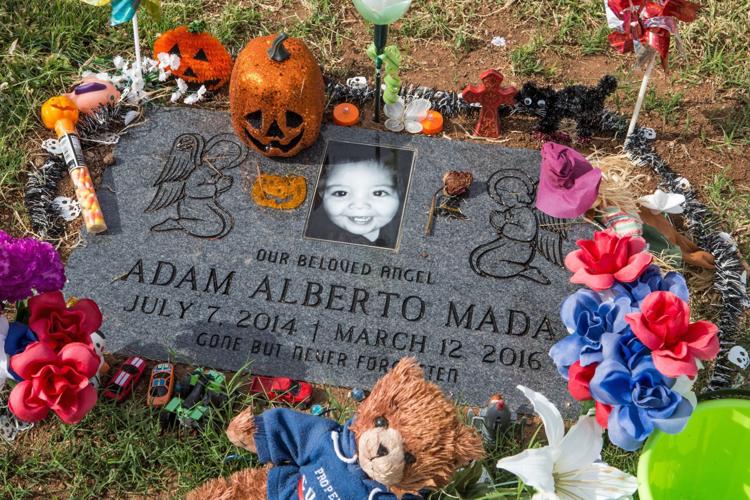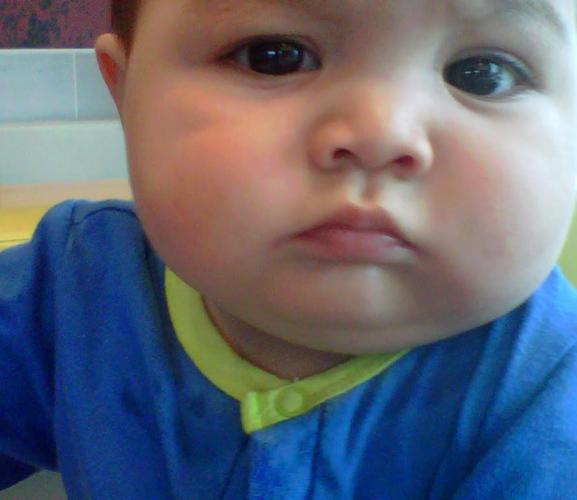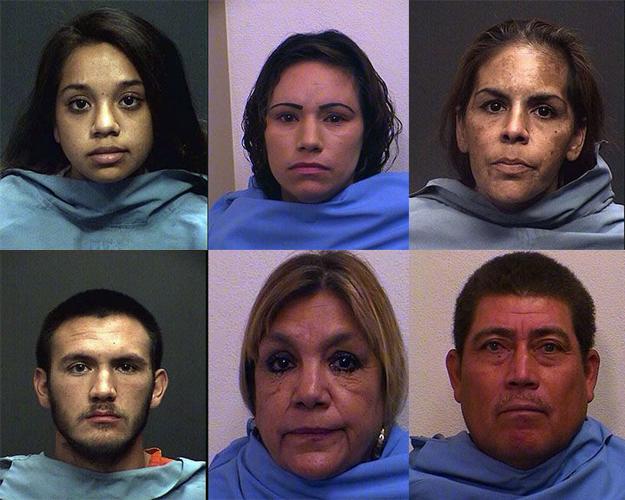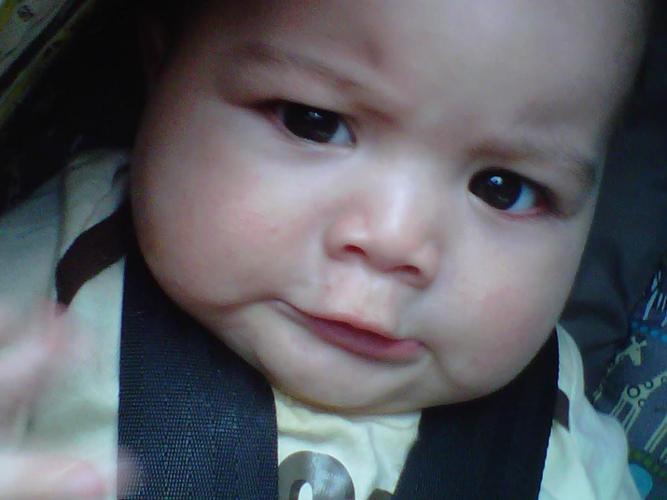Adam Mada had a chance.
He was developing well, even though his mother used drugs during her pregnancy. He had some birth abnormalities, including faulty valves and a hole between his heart’s upper chambers, but a cardiologist said he probably wouldn’t need surgery.
Adam began sitting up at 4 months, was crawling two months later and first walked a couple weeks shy of his first birthday. He loved to be held and, as he grew, he delighted in discoveries.
But he was left in a roach-infested trailer where a neglected girl of about 6, his half-sister, was being hidden .
He was left to ingest cocaine and the painkiller Percocet in the same home where his cousin, just 9 months old, nearly died after drinking methadone.
He was left to suffer ruptured organs, brain swelling and broken ribs, bones that didn’t have time to heal before others were shattered.
The Three Points toddler might have reached his second birthday if someone had reported he was being left with people not approved to be his caregivers. If the agencies responsible for protecting him had heeded warning signs about his mother’s extended family. If child welfare workers had communicated critical information with one another.
But none of that happened.
This is how Adam Mada lost his chance.
A place for Adam
Adam weighed 6 pounds, 7 ounces when he was born at Tucson Medical Center on July 7, 2014.
His mother, Alejandra Campas, already had been investigated four times by the Arizona Department of Child Safety. She had six or seven other children — records vary — and all had been removed from her care.
Adam tested positive for three painkillers at birth — codeine, hydromorphone and morphine. Like his older siblings, he wasn’t allowed to go home with his mother.
State authorities didn’t consider his father a suitable caregiver, either. He had tested positive for drugs and seemed indifferent about Adam’s mother’s drug use, records from the Arizona Department of Child Safety show.
That’s how Adam came to live with his mother’s sister, Leticia E. Henderson, in Three Points, west of Tucson. Leticia already had four other children, all under age 8, and within a year another daughter would be born.
A caseworker with Catholic Social Services who visited her trailer documented a clean and safe home. Adam’s aunt cleared background checks by the Department of Child Safety and the Department of Public Safety, and said she would adopt her nephew if necessary. She told the social worker she was a single mother, but that wasn’t true; court records show she married Jesus Gonzalez, the father of her three younger children, in 2012. Because authorities didn’t know of him, he didn’t undergo background checks that are mandatory for court-approved caregivers.
With his Aunt Leticia approved as his foster mother, a plan was in place for Adam — but the danger was already there, hidden in the details of that initial report.
Leticia’s list of potential helpers included her mother, also named Leticia Henderson. The report refers to the grandmother as an asset in her daughter’s life, and highlights that she “lives nearby and is ever present in the home.”
What the social worker didn’t note — and might not have known since home studies focus on people who will live with the child — is that Adam’s grandmother had been investigated by the Department of Child Safety 10 times, including three cases in which investigators substantiated abuse or neglect.
Adam’s Aunt Maria Alvarez, also listed by the social worker as a person who could help with the baby, would soon face felony drug charges for attempting, court records show, to smuggle 11.5 grams of heroin into a state prison unit by inserting the drug into her vagina.
The Department of Child Safety declined to answer questions on Adam’s case, including whether its caseworkers allowed him to be watched by his Aunt Maria or his grandmother. The toddler eventually died in their home.
An active, healthy boy
Adam initially had regular visits with both his parents. But by the fall of 2014, his father went to prison for trafficking stolen property.
DCS records show Adam’s mother struggled with her sobriety and her dedication to her son, so the state’s plan eventually changed from reuniting the baby with his parents to severing their rights to raise him.
Adam’s father, Alberto Mada, used his prison term to take classes on parenting, employment planning and maintaining sobriety, records show, but the little boy died before his father’s release.
The Arizona Daily Star obtained Adam’s DCS records from someone involved with the case, not from the agency. DCS still hasn’t responded to the newspaper’s request for public records, filed last June. State officials blocked out many sections, but the parts that are legible offer a hopeful story of Adam’s life and show no signs of abuse, at least in the beginning.
“The baby is developing nicely,” a September 2014 DCS report shows. “He does well during tummy time and enjoys it very much. He is tracking with his eyes, trying to speak and mumbling a lot.”
As of late January 2015, 6-month-old Adam weighed almost 20 pounds and was described as a happy baby with a strong appetite and “very chubby cheeks.” He had bonded with his aunt.
By late May that year, he was becoming more active and had slimmed down a bit. He loved to cuddle and giggle.
Another positive report in September 2015 describes Adam as “very affectionate and happy.” By November 2015, court dates were being discussed to have his aunt adopt him.
The last time the Department of Child Safety appears to have had contact with Adam was Feb. 3, when he was reported to be healthy and “very busy” playing with toys.
A month later, a caseworker scheduled a routine home visit for March 14 — but on March 11, she asked to push it to March 16 because of a scheduling conflict.
Adam died before that day arrived.
COMMUNICATION LAPSE
What Adam’s caseworker didn’t know was that in early January, just a couple of months before his death, his Aunt Leticia’s youngest child, then about 9 months old, became critically ill after ingesting methadone.
Initially, sheriff’s records show, she said her daughter had found the methadone at a park. But she told the truth to hospital staff workres, who relayed to law enforcement that the baby had ingested methadone at the trailer where her grandmother, the elder Leticia Henderson, lived.
Details about how the baby was poisoned are unclear, but babies and toddlers who drink methadone usually are given the drug to make them sleep or stop crying, said Mary Ellen Rimza, an Arizona pediatrician who authors the state’s annual Child Fatality Review.
“The younger the child, the less likely they are to have the motor skills to get into the fridge, cabinets, onto tables,” Rimsza said. Babies also lack the hand skills to remove a cap from a container and hold it properly.
In this case, although DCS won’t say why, the allegations of neglect were not substantiated and investigators closed the case within the month.
The investigation apparently included no mention of Adam, of who was caring for him while his cousin was hospitalized or of whether he was receiving proper care as the baby recovered.
A later DCS report shows investigators in the methadone case didn’t know the baby’s mother was also fostering Adam. Because of that, Adam’s caseworker was never notified, although she should have been.
That disclosure could have led to stepped-up oversight and perhaps a new foster placement — moves that might have saved Adam’s life.
Broken ribs, sepsis
The 911 call came in the early morning of March 12. A dispatcher could hear a man in the background yelling that they should have taken the baby for help sooner.
Paramedics rushed to the trailer and tried desperately to save Adam.
He was on the floor near the door. Cockroaches were everywhere and the trailer was filthy. Yellow stains on the carpet marked where Adam had vomited bile repeatedly earlier in the day. His long-sleeve onesie was caked with vomit.
Eleven people were in the trailer as paramedics worked on Adam. His grandmother and step-grandfather were there, and so was his mother — whom he wasn’t supposed to be staying with — as well as his Aunt Maria and her husband, their two children and someone hardly anyone outside the family knew existed: Adam’s half sister.
Some of those people watching the paramedics were upset, but most were strangely unresponsive, at least two of the Three Points firefighters said.
As paramedics tried to revive the little boy, they were shocked when Adam’s foster mother, his Aunt Leticia, arrived and asked whether they’d tried Narcan, an opiate antidote. One of the firefighters angrily asked her why she said that, records show, and whether Adam had been given drugs.
Family members said he hadn’t, but a hair strand test would later show that Adam had both cocaine and Percocet in his system when he died.
Adam’s aunt later told sheriff’s investigators she was so focused on her daughter’s recovery from the methadone that she didn’t make Adam a priority.
“I just feel horrible thinking that, you know, I was so worried about (my daughter) … that this whole time Adam was the one who needed me,” she told investigators after his death. “I don’t think I’m gonna be able to go home and look at his bed and know he’s not gonna come home no more.”
Here’s what was happening to Adam: He suffered blows to his abdomen that tore his digestive organs. That led to sepsis, a bacterial infection of the bloodstream.
His chin was cut, his forehead was deeply bruised and his brain was swollen.
He had 11 rib fractures, five of which likely occurred just before his death. At some point, his autopsy indicates, every one of his ribs had been broken.
Hidden child
A few days after Adam’s death, a sheriff’s deputy visiting his grandmother’s trailer as part of the investigation noticed a small foot sticking out from a pile of blankets. It was Adam’s half sister, hidden there in haste when the deputy arrived.
The girl, about 6, had never been to school. Her teeth were rotten.
She had been born at a Phoenix hospital while her mother, who later had Adam, was incarcerated. Somehow, her grandmother spirited her away — later admitting to sheriff’s deputies that she hid the girl so the state wouldn’t take her.
How that happened remains a mystery. A Department of Corrections spokesman said he could not comment on the child’s birth because of health-care privacy laws. A DCS spokeswoman said she could not speculate on whether the agency had been notified of the girl’s birth and then lost track of her.
Arizona law allows for the release of information about victims and perpetrators of child abuse that leads to death or near death, but “it does not allow us to release information on other individuals (e.g. the six year old sister in the last paragraph),” wrote Vickie Isaac, DCS’s director of communications.
As invisible as she was, that little girl turned out to be a key witness for her brother, sheriff’s records show. She told detectives that Erick Henry, their uncle by marriage to Adam’s Aunt Maria, was “mean” to Adam. She demonstrated how she’d seen Henry punch her baby brother, often in the back, records show.
The girl said she told her mother and her grandmother about her uncle’s abusive behavior. Both women confirmed that during the criminal investigation.
In the time leading up to Adam’s death, his sister told authorities, he’d try to cry, but nothing came out.
Investigators asked her to describe what that looked like. “Like, a teeny tiny tear coming out sometimes,” she said.
Doctors who viewed Adam’s autopsy said he would have been struggling for breath in those last days and final hours.
The night he died, his sister said, he turned blue before “the hospital came.”
“Dada”
Erick Henry’s parents divorced when he was a year old. His mother served time for drug charges, court records show, and he was raised primarily by his father. Drugs became part of his life at age 8, when he first smoked marijuana. He started using alcohol at age 13 and cocaine at 15, records show. He is now 23.
He was referred to juvenile court three times.
He attended both Sunnyside and Flowing Wells high schools but failed to complete ninth grade at either one. He got into trouble at school, including for possession of drugs and fighting. He later attended Calli Ollin Academy High School in downtown Tucson and did better there, but it’s unclear how long he stayed.
He eventually met and married Adam’s Aunt Maria, and the pair had two sons. They all lived in the crowded trailer, along with Adam’s grandmother, when Adam died.
Adam took to calling Erick Henry “Dada.”
“Extremely alarming”
During a meeting after Adam’s death, as DCS investigators tried to find foster homes for the other children in the immediate family, records show they were shocked by the lack of emotion relatives showed as they discussed Adam’s abuse and death.
“None of the family took responsibility for the neglect issues that appear to run rampant throughout the family,” a DCS employee noted in a report.
The family “significantly minimized” the seriousness of what had happened and tried to blame Adam’s sister and his mother, who was at the trailer recovering from surgery at the time of the toddler’s death.
Adam’s Aunt Leticia, the person legally responsible for him, refused to give investigators crucial information, contradicted herself and “failed to prioritize her duties to help (Adam) over her desire to protect herself and her family,” records show.
Leticia admitted that Adam was often at her mother’s trailer instead of in her care — a fact that Adam’s caseworker, when she later learned of it, called “extremely alarming.” Leticia denied Adam was living there although sheriff’s deputies found drawers full of clothing in his size at his grandmother’s trailer.
When detectives interviewed Erick Henry, he denied ever hitting Adam and said his nephew had been vomiting and running a fever the day he died.
Henry was initially arrested on suspicion of first-degree murder. On June 20, a Pima County grand jury indicted him on charges of second-degree murder, endangerment, and child abuse for failure to seek medical attention.
Adam’s mother, his grandmother, his step-grandfather and his two aunts were indicted on the same charges.
A trial date has not yet been set.
“Always love him”
Adam’s paternal grandmother, Regina Miranda, visits his grave weekly. It’s decorated with his favorite toys, including little cars and trucks and his beloved teddy bear in its blue sweatshirt.
Adam’s father, Alberto Mada, is out of prison now. He says he is sober and longs to turn back time.
Regina Miranda wanted to care for her grandson after he was born but says she was overlooked as a possible placement because she didn’t have a car.
“They asked, ‘How are you going to get him to his doctors’ appointments?’” she said. His Aunt Leticia “had more than me. She had her own trailer and I was living in a little apartment.”
Miranda said that when Adam came to visit, he loved to go to the store and would toddle to the closet when asked if he wanted to go. “He knew that’s where I kept his stroller,” she said. ”I feel like I’m going crazy sometimes. I miss him so much.”
Adam’s half-sister told investigators she liked to play chase with her little brother, that she would run and hide so he could look for her. The game made him laugh so hard, she said.
A Tucson psychologist who counseled the little girl after Adam’s death encouraged her to remember times like that.
They’re all she has of him now.
“I supported her and encouraged her to remember Adam happy and she thought he was probably happy now, in heaven with God,” the psychologist wrote. “I reminded her that she can always love him.”







